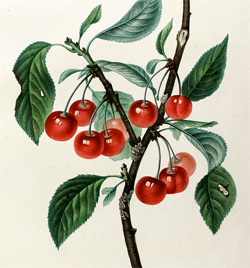 image via Swallowtail Garden Seeds
image via Swallowtail Garden Seeds
Two Groups: Sweet and Tart
The fresh cherries sold in the supermarket and roadside stands are sweet cherries. Dried cherries or pie cherries are tart, giving them a burst of intense flavor. Both sweet and tart cherry trees prefer nutrient-rich, well-drained soil with a ph between 6.0 and 7.0. Good drainage is absolutely necessary, since cherry trees require fresh water on a regular basis, but the roots will rot if the soil is too wet.
Sweet cherry trees are a bit finicky. They grow well in zones 5-7, but are not reliably winter hardy above zone 5; nor do they tolerate the heat found in zones 8-10. Only a few varieties are self-fertile, so unless you are positive your particular tree doesn’t need cross-pollination, always plant two or more trees. Sweet cherries bloom earlier than tart cherries, so they are more susceptible to crop loss from a late frost.
Tart, or sour cherries are more widely adopted than their sweet counterparts, with some varieties able to prosper in zones 3, and others in zone 8. Tart cherries are susceptible to the same diseases and pests as sweet cherries.
Standard vs. Dwarf Cherry Trees
Standard sweet cherry trees can grow to 50 feet tall, while tart cherry trees only grow to half that height. Dwarf cherry trees can produce varieties of either sweet or tart cherries, and only grow 8-20 feet high. In general, keeping trees 8-12 feet high makes harvesting and caring for the trees easier.

A simple comparison of fruit tree sizes.
Image from permies.com.
Cherry Diseases and Pests to Watch Out For
Brown rot, perennial canker, powdery mildew and a number of viruses attack cherry trees. For the most part, keeping your trees strong by planting in fertile, well-drained soil, and ensuring they get water on a regular basis will help the trees fend off diseases. Fertilize your trees in late winter and provide mulch to keep down the weeds. Check your trees for damage at least once a month, and take care of any problems before they spread.
 Cherry leaf spot is caused by a fungus
Cherry leaf spot is caused by a fungusin humid and damp conditions.
Most diseases and pests, such as mites, peach tree borers and shothole borers will attack the trunk or larger branches of the tree, so make sure to protect the bark. Surround the trunk with wire or another barrier to keep deer, rabbits, voles and other animals from chewing on the bark. In the spring, you may want to add mosquito netting to prevent egg-laying insects from boring into the trunk.
Never mow or trim grass very near cherry trees, as anything caught in the mower or trimmer can fly out and damage the trunk or branches. If you see holes oozing what appears to be either a gummy substance or a sawdust-like material, poke a needle in the hole to kill the insect, and then spray the area with garlic oil.
Garlic oil can be made by mixing one cup of chopped, crushed garlic in one quart of mineral oil and letting it sit overnight. Strain out the garlic, and use the oil to spray anywhere on the trunk or branches where you see evidence of mold, mildew, disease, or pests.
This will also deter deer and other mammals from eating the bark.
Bird Netting to Protect Your Crop
There are three ways to protect your cherries from being eaten by birds. One way is by planting yellow cherries, which are less likely to attract birds. However, yellow cherries don’t have as many of the antioxidants and other nutrients present in red cherries. A second way is to plant a mulberry tree near the cherry trees. Birds will be attracted to the mulberries and will be more likely to leave your cherries alone.
Finally, a third way to deter birds is by installing protective netting over the trees, making sure that the netting reaches completely to the ground and is anchored so birds don’t inadvertently get under the netting. Make sure to cover the trees before the berries turn ripe and the birds start feasting. This is another reason dwarf cherry trees are easier to care for.
Sweet, tart, nutritious, and great for eating fresh, canned or dried, cherries are a useful crop. Why not try planting a few trees?
Further Reading
Try Your Luck with Cherries Mother Earth News.